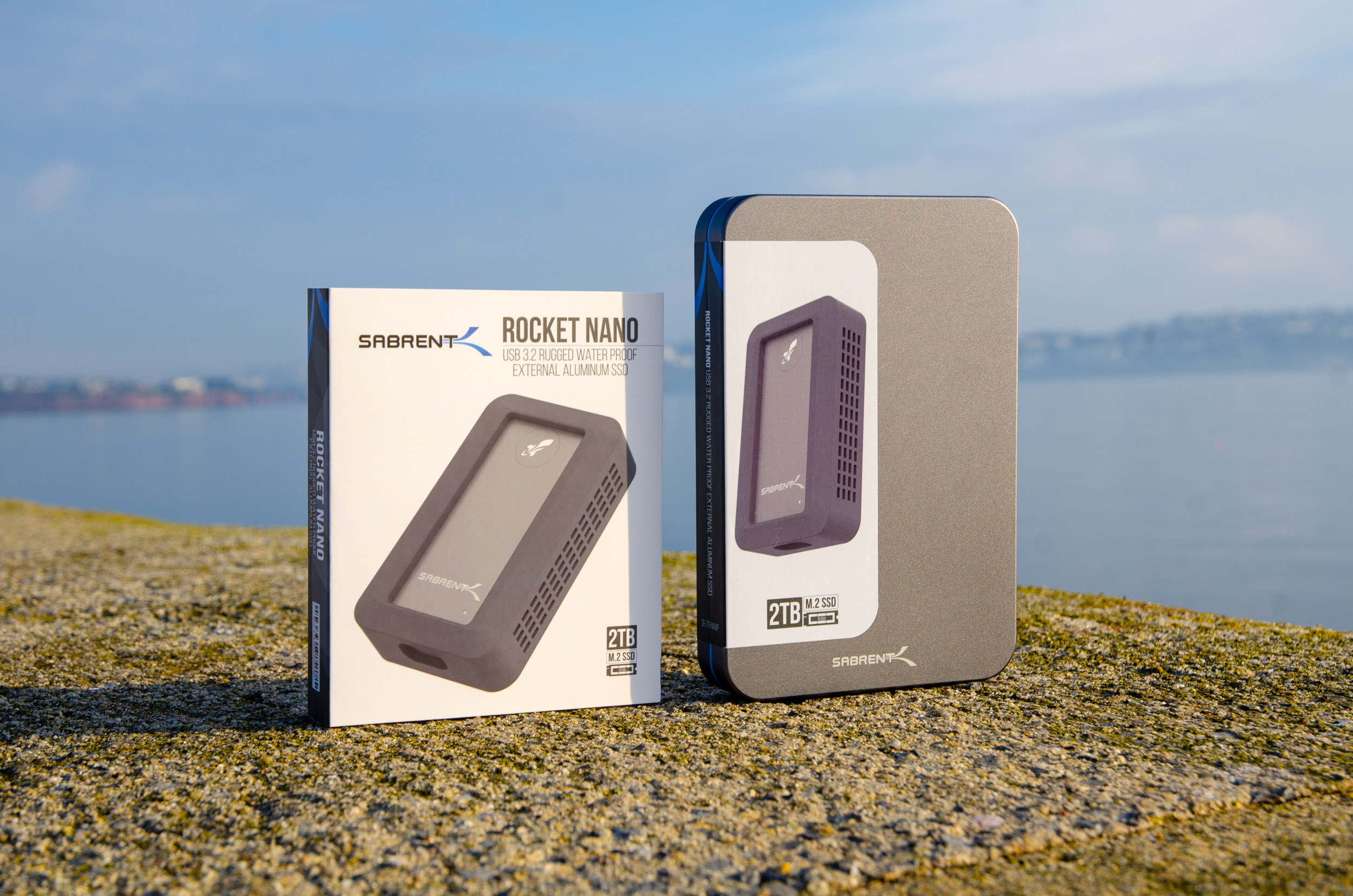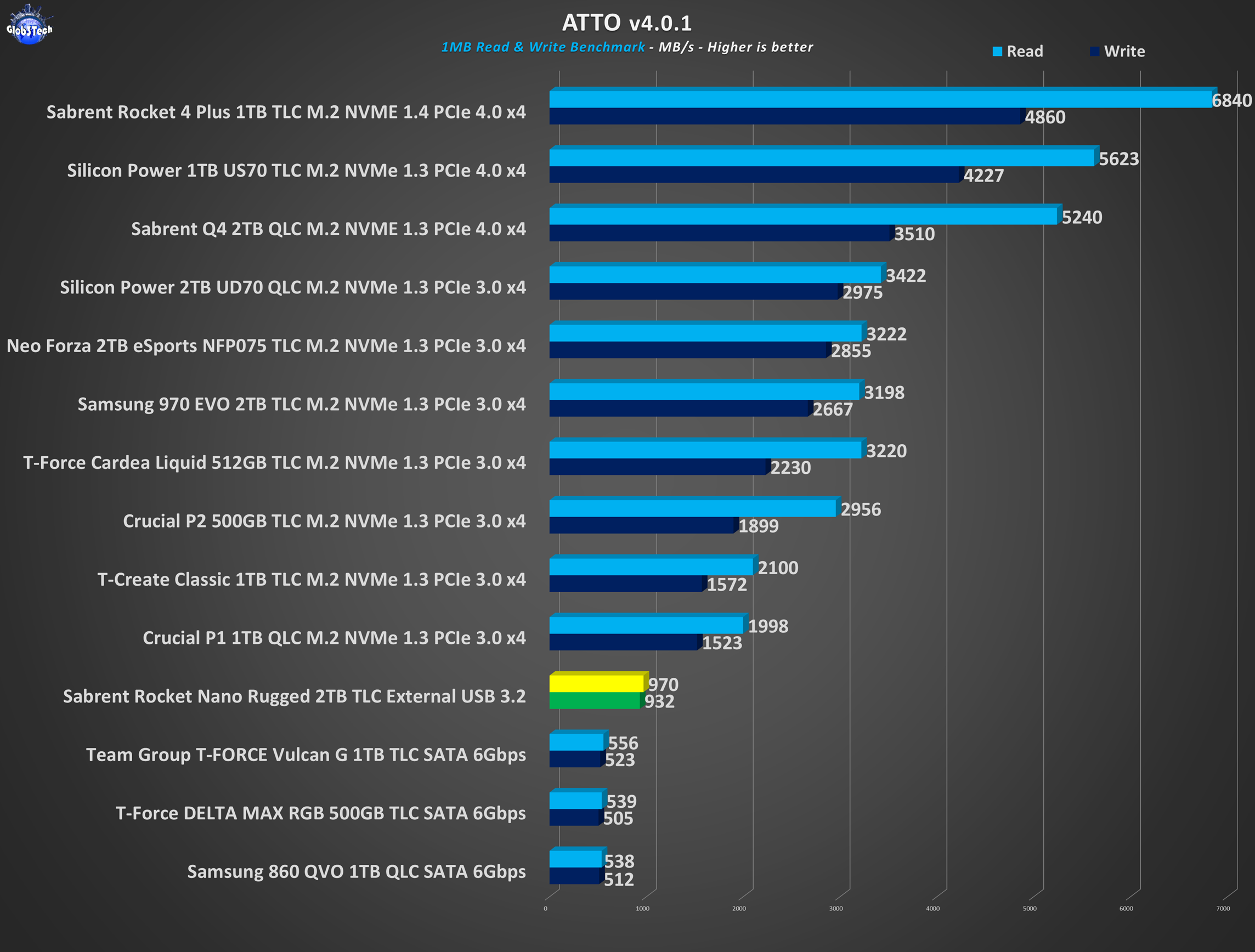
Sometimes you need extra storage that is highly portable, compact, waterproof and fast. Meet Sabrent’s Rocket Nano Rugged 2TB external NVME USB 3.2 SSD. It’s rated for IP67 water/dust resistant and 1-meter drops and its interface provides speeds of up to 1000 MB/s. On top of this, to further protect its slim aluminum alloy sandblasted shell, it even comes with a rubber bumper guard.
Sabrent’s commitment is to offer the latest technology and the highest quality consumer electronic products at an affordable cost to everyone. Since its founding, Sabrent has consistently delivered to market a full line of computer peripherals and accessories that incorporate style, quality and the latest technologies available.
Prices and Availability
You can choose between 3 capacity options (512GB, 1TB and 2TB) and 4 colours for the aluminium shell (black, red, blue and grey). Considering its main specs, the 10 Gbps interface and the capacity, its price tag is quite high over something like the Crucial X8 for example. So it’s up to you if you can justify that price gap for the extra IP67 rating that the Sabrent Nano Rugged offers. Alas, it’s cheaper than the SanDisk Extreme PRO Portable 2TB.
*07.12.21 - The video review is live as well!*
Highlights and Specification
*Courtesy of their website.
WATER RESISTANCE - Fully compliant with IP67 specification. Protection from immersion in fresh water with a depth of 1 meter (3.3 ft) for up to 30 minutes. RUGGED DESIGN - 1 meter (3.3 ft) drop tested. Seald against harmfull dust.
COMPATIBILITY - Designed to work with both Windows and Mac OS, so you can transfer data between almost any computer in the world. Complies with trim, UASP, and firmware is upgradable.
PLUG & PLAY - OS independent, and fully bus powered, No drivers required.
SPEED - Ultra-fast 10Gbps throughput, low latency and power efficient. At up to 1000MB/s
DESIGN - Ultra slim aluminum alloy sandblasted shell. Sleek, Durable, and Convenient. Portable yet durable, ideal for traveling.
FUNCTIONALITY - Perfect for a variety of uses including data transfer, high-speed storage, data backup, and more.
Specs:
* Model - Sabrent Rocket Nano Rugged w/ bumper guard - SB-2TB-NAWP
* Interface - USB 3.2 Gen 2 Type-C
* Capacity - 2048 GB
* Controller - (PCIe to USB bridge) JMicron JMS583 + Sabrent custom RKT 301 Phison E13T
* Flash - Kioxia (Toshiba) BiCS 4 96L 3D TLC
* Dimensions - 37.85 x 66 x 12.7 mm / 7.5 x 5.2 x 0.69 in
* Weight - 78 grams (without cable and bumper) / 92 grams (with bumper, without cable)
* Warranty - 3-year warranty
* IP Rating - IP67
Visual Inspection
All Sabrent products regardless of size, come in metal packaging and excellent branding; thus maximum points here.
The main specs and highlights are printed on the back of the sleeve and also on the gunmetal case.
Inside, the SSD has its own foam sleeve while the cables are secured in the top part.
You get two Sabrent branded cables, one USB Type-C to Type-C (200mm) and one USB Type-A to Type-C (300mm).
Here is the sexy rugged external SSD that only weighs 78g without the shell. You can get this one without the rubbed bumper shell but even with this on, it has a tiny footprint: 72 mm long, 43 mm wide and 17 mm thick.
Here it is next to a Samsung Galaxy Note 9 smartphone for size perspective.
The CNC-machined body is made from high-grade aerospace aluminium and it’s IP67 water and dust resistant. This will ensure its operation even after submerging it in 1 meter of water for 30 minutes. On the front it has the Sabrent logo and that small hole on the bottom is the activity LED.
On the back it has these two black tabs that hide the mounting screws to access the NVME inside and which also act as extra friction for the outer rubber cage to not move around.
The product code and serial number are printed also on the back.
This is the USB Type-C port which is handled by the JMicron JMS583 controller, that facilitates the PCIe to USB bridge communication.
Inside the enclosure we have the M.2 2242 version of the Rocket PCIe NVMe SSD (SB-1342-2TB) which has a custom RKT 301 memory controller but rebranded to Phison PS5013-E13T. The 96-layer BiCS4 3D TLC NAND flash are from Toshiba (now KIOXIA) with no DRAM cache onboard.
Let’s bring it back to the office and test it out.
When in use this blue LED will blink.
Testing methodology
* Synthetic and real life big file transfer tests - a game folder of 119GB of mixed files and a single 9GB .mkv video file to test the burst speed and the SLC cache if present.
* All SSDs were secure-erased before our tests started
* Between tests, drives are left idle for 1 minute to allow them to flush and reorganise their internal data.
* Steps have been taken to ensure that the CPU’s power-saving features don’t interfere with any of our results. All of the CPU’s low-power states have been disabled.
* In order to minimise random variation, each of the real-life performance tests are run a few times with reboots in-between tests to reduce the impact of disk cache.
* (SATA SSDs only) Make sure you use a SATA 6Gbps capable motherboard and a matching cable to avoid bottle-necking. Then double check in the BIOS that you have the AHCI mode activated for another maximum performance tip.
* For the Gen4 x4 M.2s, you have to make sure you have a compatible motherboard that accepts and delivers the new bandwidth. Otherwise, it will work only in Gen3 x4 mode.
* All of the benchmarks for the internal drives were done with a 92mm side fan placed 2cm away and set at 60% RPM. Then the temperature scenarios and the heatsink were tested separately with an ambient temp of 22°C.
* For AMD users, make sure you update your motherboard chipset drivers from here.
Hardware used:
- CPU: AMD Ryzen 3 3100
- CPU Cooler: Asetek 645LT 92mm AIO
- Motherboard: ASUS ROG STRIX B550-i Gaming mITX @ BIOS 2407
- RAM: 64GB Neo Forza MARS RGB 3200 MHz CL16
- Boot SSD: Silicon Power 2TB UD70 M.2 Gen3 x4 QLC PCIe NVMe 1.3
- Video card(s): ASUS GTX 1080 STRIX A8G
- PSU: Corsair SF750 SFX Platinum
- Case: DAN A4-SFX V4.1 ITX
- Case fans 92 mm: Noctua NF-A9x14 HS-PWM.chromax.black.swap
Competition SSDs:
- Sabrent Rocket 4 Plus 1TB TLC M.2 PCIe NVMe 1.4 Gen4x4
- Samsung 970 EVO Plus 2TB TLC M.2 PCIe NVMe 1.3 Gen3x4
- Samsung 860 QVO 1TB QLC SATA 2.5″
- Crucial P1 M.2 1TB QLC PCIe NVMe 1.3 Gen3x4
- Crucial P2 M.2 500GB TLC PCIe NVMe 1.3 Gen3x4
- Team Group T-Force DELTA MAX RGB 500GB TLC SATA 2.5″
- Team Group T-Force Vulcan G 1TB TLC SATA 2.5″
- Team Group T-Force Cardea Liquid 512GB TLC PCIe NVMe 1.3 Gen3x4
- Team Group T-Create Classic 1TB TLC PCIe NVMe 1.3 Gen3x4
- Silicon Power 1TB US70 TLC M.2 PCIe NVMe 1.3 Gen4x4
- Silicon Power 2TB UD70 QLC M.2 PCIe NVMe 1.3 Gen3x4
- Silicon Power 1TB A80 TLC M.2 PCIe NVMe 1.3 Gen3x4
- Silicon Power 1TB A60 TLC M.2 PCIe NVMe 1.3 Gen3x4
- Neo Forza eSports NFP075 2TB TLC M.2 PCIe NVMe 1.3 Gen3x4
Software:
- Windows 10 Pro x64 Version 21H1
- HD Tune Pro v5.70
- ATTO v4.01
- Crystal Disk Mark v7.0.0
- HWMonitor v1.43
Testing, Results and Analysis
It comes out of the box formatted and ready to go with even its own Sabrent icon.
HD Tune Pro – which is a hard disk / SSD utility with many functions. It can be used to measure the drive’s performance, scan for errors, check the health status (S.M.A.R.T.), securely erase all data and much more.
It has no match to internal NVMe SSDs but that’s not its main purpose.
Moving to the next utility - Crystal Disk Mark – this one is designed to quickly test the performance of the drives.
In the both the “read” and “write” benchmark tests, the Rocket Nano Rugged confirms its advertised bandwidth.
To conclude the synthetic tests, here is ATTO which is another performance measurement tool to test any manufacturers RAID controllers, storage controllers, host bus adaptors (HBAs), hard drives and SSD drives. This one just reconfirms the numbers from the previous test.
Considering this Nano Rocket Rugged will make an excellent external games’ library (like Steam etc), let’s see how are the loading times when compared to internal mounted drives.
The final practical test revolves around some real life copy tests. Firstly, we will copy to the SSD a single 9GB .mkv video file to test the burst speed followed by a big 119GB installation folder from the Red Dead Redemption 2 game.
Both the burst speed test and even the large file transfer, the Sabrent Rocket Nano maintains a sustained and constant write speed, despite its DRAM-less nature.
Now let’s inspect the operating temps. The aluminium shell acts as a heatsink as well and even with the rubber cage on, there is nothing to worry about. With the laser temp gun it never went above 50°C.
Conclusion
The Sabrent Rocket Nano in its biggest offering, is a cool and effective gadget. It’s one of the very few TLC equipped external IP67 offerings on the market that has such a small footprint. Despite its DRAM-less nature, it still manages to offer a consistent throughput even in the large file transfers, since this is why you would get such a device, to back-up loads of data. The build construction is top notch which consolidates its sleek overall design and the IP67 certification plus the rubber bumper shell, are big points towards extra peace of mind. The asking price might be a bit high if you are just after capacity-to-speed ratio but the Nano Rugged is in a different niche.
The good:
+ Superb build quality
+ Consistent transfer speeds
+ TLC cells
+ IP67 certification
+ Two included cables
+ Rubber protective shell
+ 3 years warranty
The bad:
- Price
Glob3trotters “Excellent!” Award 4.5 out of 5






































